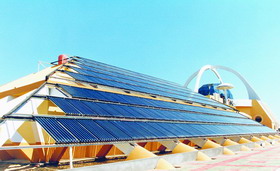 |
 |
||||||||||||||||
|
||
Rushan, Shandong Province, China |
||
Due to the vast amount of electric power required to run an air-conditioning system, worldwide power demand for this technology is very large. In order to better meet this large demand, Beijing Solar Energy Research Institute (BSERI) in co-operation with Sunda has conducted extensive research in this area. A demonstration system with 100kW cooling capacity was successfully designed and set up in Shandong Province, China, and started working in September 1999. The demonstration system is a solar absorption air-conditioning system, powered by heat-pipe evacuated tube collectors manufactured by Sunda. Solar cooling provides an obvious advantage. It provides maximal economic benefit since it matches highest cooling demand with the strongest sunshine in summer. It is a truly multifunctional system providing various functions including space cooling in summer, space heating in winter and domestic water heating all year-round. |
|
|
The solar air-conditioning system was installed in the Solar Energy Hall of the Chinese Renewable Energy Popular Science Park in the Tourist & Holiday-Spending Zone. The hall is a two-story building with a construction area of over 1000 m² which had been architecturally designed to meet the requirements of a solar collector array placement. The location has an annual average daily solar irradiation of around 17.3 MJ/m², an annual average ambient temperature of around 12.3°C and ambient temperature between the highest 33.1°C in summer and the lowest -7.8°C in winter. The system has a collector gross area of 540 m² using 2,160 heat-pipe evacuated tubes. It consists of heat-pipe evacuated tube collector array, lithium-bromide absorption chiller, cooling tower, water storage tanks, circulating pumps, fan-coil units, auxiliary oil-burned boiler and control device. Evacuated tubes with a semi-cylindrical absorber plate are selected to obtain the maximal solar irradiation over a day. The use of bent absorber plates gives the system an energy edge over flat absorber plates of 10-14%. During operation the performance of the system in all seasons was tested. With 50%, the system reached the highest efficiency for domestic water heating. Efficiencies of over 40% for space cooling and near 35% for space heating also show the system's suitability for applications at higher operating temperature and lower ambient temperature. A smaller hot-water storage tank and a chilled-water storage tank were both proving to be useful in not only reaching the required temperature in the morning but also in reducing heat losses. |
||
 |
||
|



